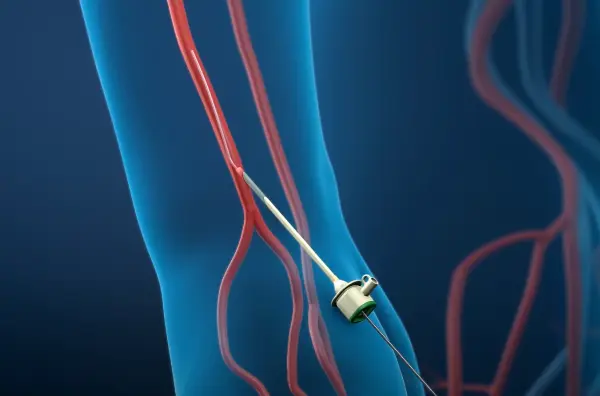What is Angioplasty? Angioplasty is a frequently conducted medical intervention utilized for the treatment of constricted or obstructed blood vessels, specifically arteries. Referred to as percutaneous transluminal angioplasty (PTA), this procedure, which involves minimal invasiveness, is commonly performed to enhance blood circulation to essential organs such as the heart, brain, or other crucial body parts.
When Angioplasty is Required
In this analysis, we will explore the circumstances where angioplasty is deemed necessary as a medical intervention to expand and remove obstructions in clogged blood vessels, thus restoring the regular circulation of blood to the heart muscle.
- Coronary Artery Disease (CAD):
Angioplasty is commonly used for patients with CAD, which is a condition characterized by the narrowing of arteries supplying blood to the heart due to plaque buildup. This procedure aids in relieving chest pain (angina), enhancing blood flow, and lowering the chances of a heart attack. - Heart Attack (Myocardial Infarction):
Angioplasty is the main method of treatment for individuals who have suffered from a heart attack. A prompt intervention is crucial in situations where a blood clot fully obstructs a coronary artery, as it helps resume blood circulation and stops any additional harm to the heart tissue. Typically, this procedure is conducted simultaneously with the placement of a stent. - Unstable Angina:
This condition occurs when the blood supply to the heart is critically reduced but not completely blocked. Angioplasty can swiftly alleviate the symptoms of unstable angina and, if needed, be followed by stent insertion to maintain an open passage in the artery. - Chronic Total Occlusion (CTO):
CTO refers to a long-standing artery blockage, typically lasting over three months. Angioplasty can be performed to recanalize such stubborn blockages and restore blood flow, which can subsequently improve heart function and reduce symptoms. - Restenosis:
In some cases, after an initial angioplasty, the treated artery may become narrow again due to scar tissue formation (restenosis). Angioplasty is employed as a remedial measure to reopen the constricted vessel and enhance blood flow. - Stable Angina:
For patients experiencing angina symptoms that significantly affect their quality of life, angioplasty may be recommended to relieve the narrowed arteries and improve blood flow. It can offer substantial relief, reducing the frequency and severity of anginal episodes. - Failing Bypass Grafts:
In cases where previous bypass grafts used to redirect blood flow around blocked arteries are not working properly, angioplasty may be used to unblock the bypass grafts and ensure that enough blood reaches the heart. - Preoperative Preparation:
Angioplasty can be carried out in certain situations to enhance blood circulation to the heart before significant surgeries like valve replacement or non-cardiac procedures, guaranteeing that the heart is operating at its best ability.
Angioplasty is a widely accepted and proven procedure that enables cardiac specialists to intervene swiftly, alleviating symptoms, preventing further damage, and saving lives. However, it is essential to consult with a medical professional to determine the most appropriate treatment plan tailored to individual circumstances.
How Angioplasty is Performed
The procedure entails unblocking the affected vessel, thereby promoting unhindered blood flow, enhancing circulation, and providing relief from associated symptoms. A comprehensive outline of the sequential process involved in performing angioplasty is as follows.
Step 1: Preparing for the Procedure
- The patient is typically asked to fast for a few hours before the procedure.
- Local anesthesia is given to the patient before the angioplasty in order to numb the specific area where the procedure will take place.
Step 2: Inserting the Catheter
- A small incision is made at the site where the catheter will be inserted, usually in the groin or the arm.
- Afterward, the doctor employs a needle to gain entry to the blood vessel and introduces a pliable plastic tube known as a catheter into the bloodstream.
- With the assistance of X-ray imaging, the catheter is cautiously navigated through the bloodstream until it reaches the specific region that is affected.
Step 3: Balloon Inflation
- After the catheter is placed correctly, a smaller balloon catheter is inserted through the primary catheter and moved forward until it reaches the location of the obstruction.
- The balloon is then inflated, compressing the plaque or fatty deposits against the walls of the blood vessel.
- The pressure from the inflating balloon helps to widen the narrowed or blocked artery, restoring blood flow.
- The balloon is deflated and removed after a short period, usually a few seconds to a minute.
Step 4: Stent Placement (if necessary)
- In some cases, a stent may be placed during the angioplasty procedure.
- A stent is a tiny tube made of metal mesh that can be inserted into the affected area in order to maintain the openness of the blood vessel.
- The stent is mounted on a balloon catheter and is expanded when the balloon is inflated.
- Once the stent is expanded, the balloon is deflated and removed, leaving the stent in place to provide support to the artery.
Step 5: Post-Procedure Care
- After the procedure, the catheter is removed, and the incision site is cleaned and dressed.
- Pressure may be applied to the site to control any bleeding.
- Once the patient is transferred to a designated recovery space, their essential body functions are closely observed and monitored until they become stable.
- The majority of patients can anticipate being released within a day, although a few might need to stay longer based on their condition.
- After undergoing the procedure, it is crucial to abide by the recommended medications and lifestyle modifications in order to uphold the advantages of the angioplasty treatment.
Success Rate and Prognosis of Angioplasty
The success rate of angioplasty is generally quite high. According to medical research, the procedure successfully opens up blocked arteries in approximately 90% to 95% of cases. This means that a significant majority of patients undergoing angioplasty experience improved blood flow to their heart and relief from symptoms such as chest pain.
However, it’s worth noting that the success of angioplasty may vary depending on several factors. The location and severity of the blockage, as well as the overall health of the patient, can impact the outcome of the procedure. In some cases, the arteries may re-narrow over time or the blockage may return. To mitigate these risks, doctors often use stents during the angioplasty procedure.
Stents are tiny, scaffold-like devices made of metal or drug-coated material that are inserted into the artery to help keep it open. The use of stents has significantly improved the long-term success rate of angioplasty by reducing the chances of re-narrowing. According to studies, the risk of re-narrowing is reduced to around 15% to 20% when stents are used.
Apart from the success rate, understanding the prognosis of angioplasty is also crucial for patients. After a successful angioplasty procedure, individuals typically experience relief from symptoms such as chest pain, shortness of breath, and fatigue. The improved blood flow allows the heart to function more effectively, increasing overall cardiac health.
In some cases, angioplasty may be performed as an emergency procedure during a heart attack. In these situations, the prompt restoration of blood flow can significantly limit heart muscle damage and improve the patient’s chances of survival.
While angioplasty is generally considered safe and effective, like any medical procedure, it carries certain risks. These risks include blood vessel damage, allergic reactions, bleeding, and the potential for blood clots. However, the overall likelihood of experiencing serious complications is relatively low.
Angioplasty Cost Comparison Chart
| Clinic Name | Location | Average Angioplasty Cost (USD) |
|---|---|---|
| ABC Hospital | New York | $15,000 |
| XYZ Clinic | California | $12,500 |
| DEF Medical | Texas | $14,000 |
| GHI Center | Florida | $13,000 |
| JKL Hospital | Illinois | $12,000 |
About the Author
Reyus Mammadli is the author of this health blog since 2008. With a background in medical and biotechnical devices, he has over 15 years of experience working with medical literature and expert guidelines from WHO, CDC, Mayo Clinic, and others. His goal is to present clear, accurate health information for everyday readers — not as a substitute for medical advice.







